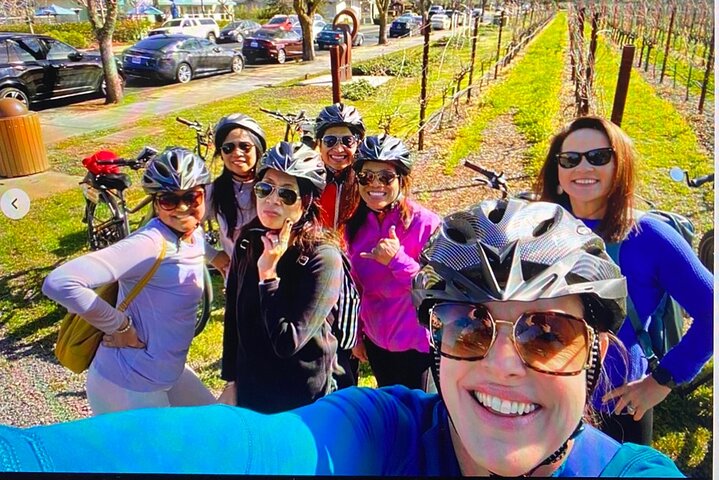Pedal, Pour, Picnic: A Self-Guided E‑Bike Day Through Napa Valley
Cruise vineyard rows, taste local wines, and picnic your way through Napa on an easy electric ride.
You start the morning with a key in your pocket, a picnic box from a local bakery tucked into a pannier, and an e‑bike that hums like a small, compliant engine beneath you. The first pedal is mostly ceremony—the machine does the work—yet the motion is immediate: vine rows open like curtains, dawn light slices through trellises, and the valley exhales. The air carries grape-sweet earth and a hint of espresso from a corner café as you roll away from the shop and onto a nearly traffic-free, paved bike path that runs beside the Napa River. The day stretches ahead in manageable pieces—flat mileage for tasting-room hopping, a few rolling climbs for the ones you want to test on level three or four pedal assist, and wide shoulders to pass slower riders without stress.
Trail Wisdom
Charge Before You Roll
Confirm battery level before leaving the shop and plan routes within the 30–50 mile range to avoid mid-day surprises.
Hydrate and Snack Often
Bring a hydration pack or 1–2 liters of water and use the picnic as a midpoint refuel to keep energy steady.
Book Tastings Ahead
Many small tasting rooms require appointments—reserve slots for midday stops to avoid long waits.
Carry a Mini Repair Kit
Include a spare tube, pump, and tire levers; while shops exist, fixes are faster and cheaper on the trail.
Local Knowledge
Hidden Gems
- •Alston Park — a white‑fenced ridge with quiet trails and valley views
- •Bothe‑Napa Valley State Park — a shaded alternative with redwoods and picnic spots
Wildlife
White‑tailed and mule deer, Red‑tailed hawks and other raptors
Conservation Note
Many Napa vineyards now practice sustainable and organic farming; stay on public paths, carry out trash, and support wineries that prioritize conservation.
Napa Valley evolved from 19th‑century vineyards and was designated an American Viticultural Area in 1981, a key step in its global wine recognition.
Seasonal Guide
spring
Best for: Wildflowers and green vineyards, Fewer crowds, Cool morning rides
Challenges: Unpredictable rain, Chilly mornings
Expect fresh green landscapes and mild temperatures; pack a light rain shell for variable weather.
summer
Best for: Long daylight hours, Warm vineyard picnics, Outdoor festivals
Challenges: Heat mid-day, Bigger crowds
Sunny days are great for long loops—start early to beat the heat and wear high SPF sunscreen.
fall
Best for: Harvest activity, Golden light for photos, Wine release events
Challenges: Busy tasting rooms, Higher accommodation rates
Harvest season delivers vivid color and energy—book tastings and lodging well in advance.
winter
Best for: Quiet roads, Lower rates, Crisp visibility for views
Challenges: Cooler, wet weather, Some wineries on limited hours
Winters are quieter and atmospheric; dress in layers and expect cooler afternoon temperatures.
Photographer's Notes
What to Bring
HelmetEssential
Protects your head and is often required by rental shops—fit should be snug and adjustable.
Hydration Pack or Water BottlesEssential
Keeps you hydrated over long sunny stretches; hands-free sips are easiest when riding.
Padded Cycling Shorts
Adds comfort for a day in the saddle, especially if you plan 20+ miles.
Light Rain Shell or Windbreaker
Useful for unexpected showers or cool valley breezes—packs small when not needed.
Common Questions
Is prior e‑bike experience required?
No—basic bike-handling skills are sufficient; the e‑bike's pedal assist levels let you choose how much help you want.
Are helmets and locks provided?
Many rentals include helmets and a basic lock—confirm with the provider when booking to be sure.
How far can I realistically ride in a day?
Battery range is 30–50 miles; a comfortable self‑guided day with stops and a picnic is usually 20–35 miles.
Can I visit multiple wineries without a designated driver?
Yes—e‑bikes avoid the need for a driver, but check each tasting room's policy on cyclists and book appointments as needed.
Is the route traffic-heavy?
Napa has a mix: dedicated paths and bike lanes exist, but you'll also encounter quiet secondary roads shared with cars—ride defensively.
What happens if the bike battery dies?
Most bikes can be pedaled without assist at reduced speed; providers often offer support or advice if you contact them before leaving the shop.
What to Pack
Helmet (safety), Hydration pack or 2 water bottles (stay hydrated), Sunscreen and sunglasses (protect against strong valley sun), Small repair kit and ID (fix flats and carry emergency info)
Did You Know
Napa Valley was designated an American Viticultural Area (AVA) in 1981, helping formalize its status as one of the United States' premier wine regions.
Quick Travel Tips
Start early to avoid heat and crowds; reserve tasting appointments during harvest; confirm helmet and lock availability with the shop; wear layers for variable valley weather.
Local Flavor
After a ride, head to Oxbow Public Market for seasonal produce and local bites, or find a small tasting room in downtown Napa for a relaxed glass. Many bakeries and delis will pack picnic boxes—use them by a river bench or vineyard overlook for the full experience.
Logistics Snapshot
Closest airport: San Francisco International (SFO) ~50 miles / 1.5 hours drive; Trailhead/Shop: downtown Napa (confirm pickup location); Driving distance from San Francisco: ~1–1.5 hours; Cell service: generally good on main roads, patchy in some valley shoulders; Permits/passes: no statewide permit for cycling, but book winery tastings in advance.
Sustainability Note
Support vineyards that use sustainable practices, keep to public paths, pack out all trash, and avoid disturbing riparian areas—the valley's long-term health depends on small daily choices.
